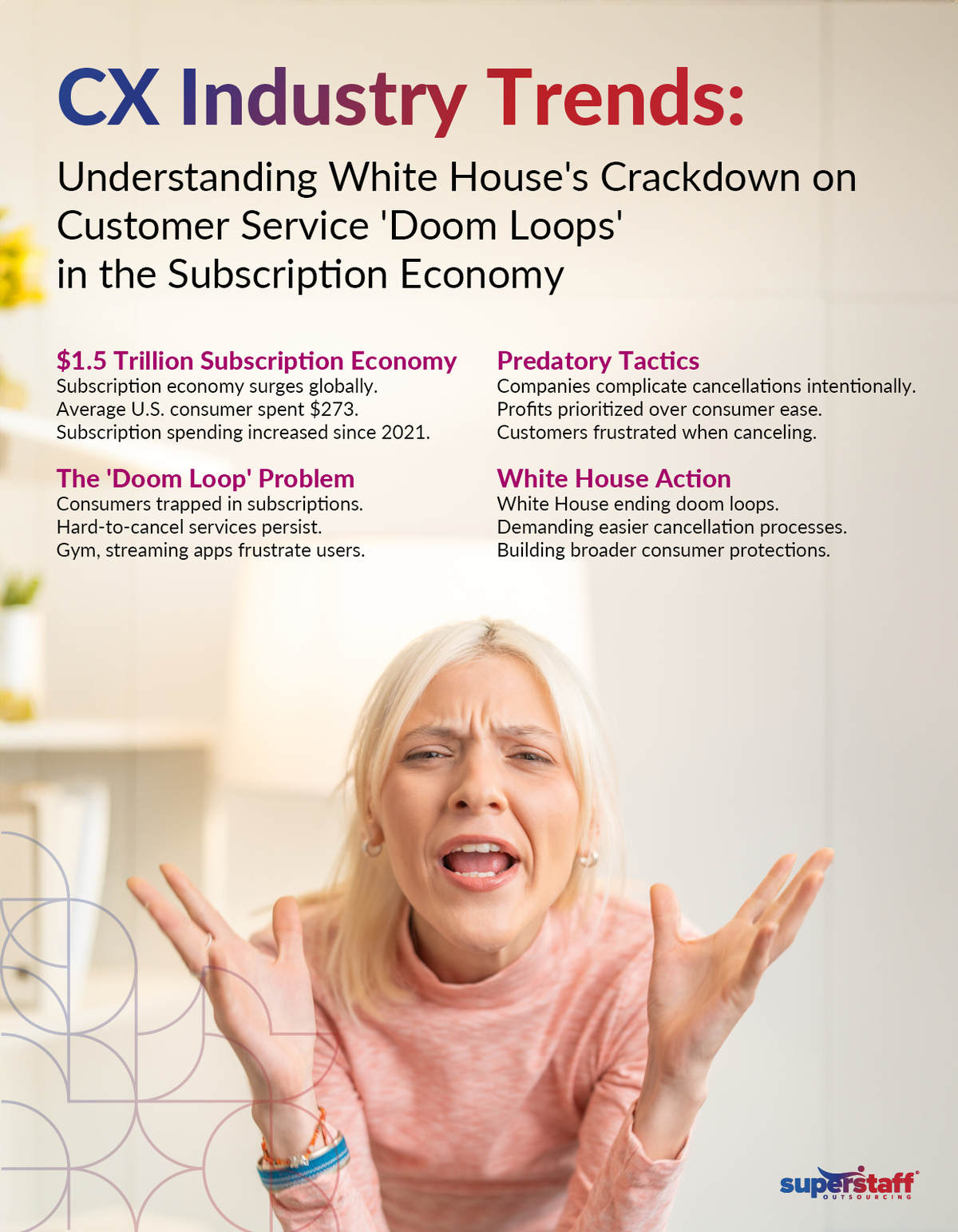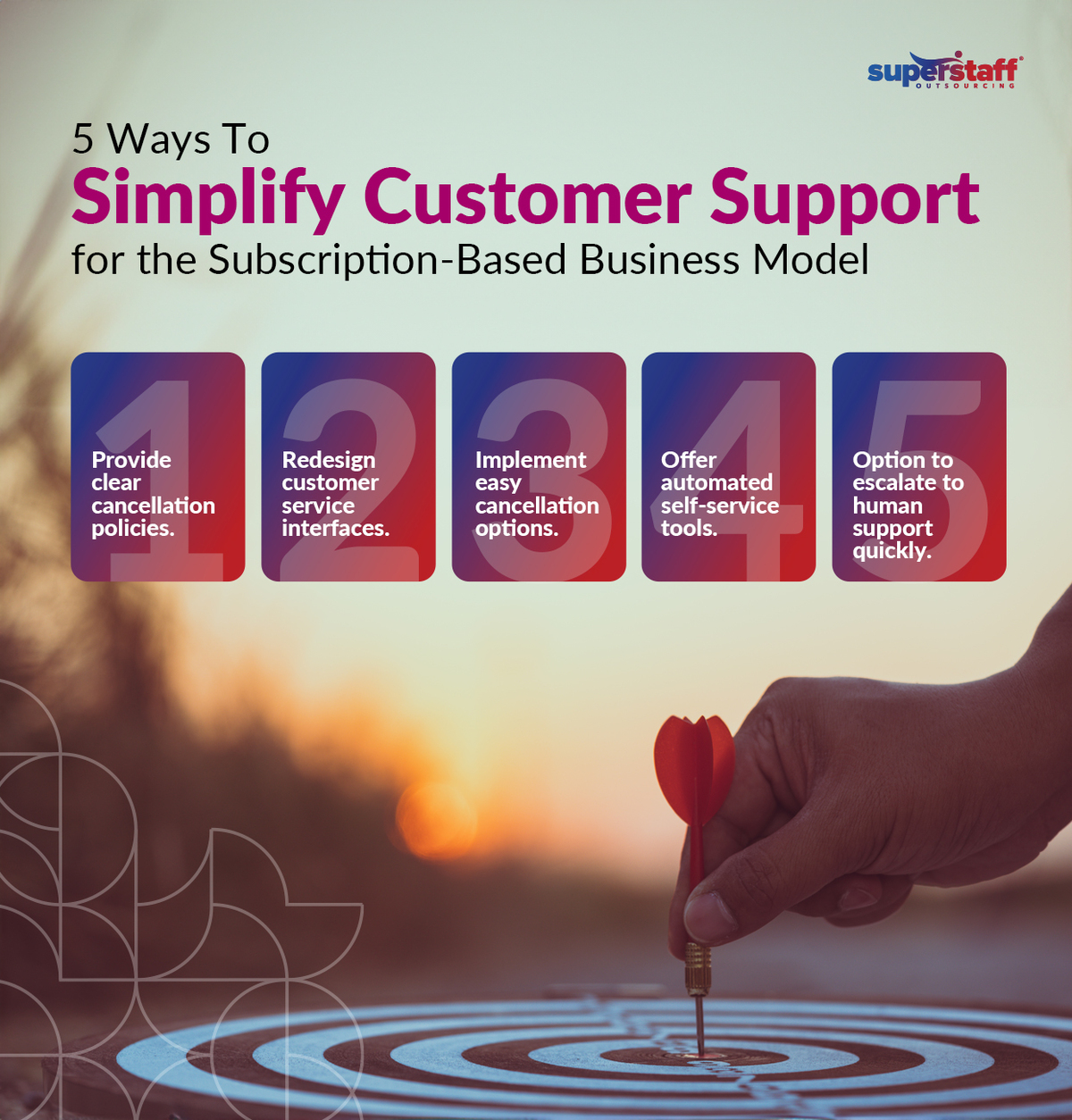
Your customers know the struggle all too well — getting stuck on hold for what feels like an eternity, fighting to cancel a subscription they no longer want, and navigating piles of paperwork just to get a refund they’re owed. Recognizing these hassles, the Biden-Harris Administration has stepped up with a bold new initiative that would eliminate these unnecessary customer service “doom loops.”
This new policy promises to eliminate cumbersome cancellation processes and enforce automatic refunds, challenging brands to rethink their strategies. While this is a welcome change for consumers, businesses like yours may struggle to navigate this shift. In this blog, we’ll explore how you can adapt to these regulatory changes, transforming short-term challenges into long-term opportunities for rebuilding trust, enhancing customer satisfaction, and thriving in a more transparent, consumer-focused market.
Understanding White House’s Crackdown on Customer Service ‘Doom Loops’
As the global subscription economy surges towards a projected $1.5 trillion market, consumers increasingly feel the weight of “doom loops.” With the average U.S. consumer spending $273 monthly on subscriptions in 2021 — a significant jump from only $237 in 2018 — the convenience of managing these services has become a significant concern.
Whether it’s a gym membership, streaming service, or app subscription, doom loops frustrate consumers trapped in difficult-to-cancel subscriptions. Some companies design convoluted processes to make cancellation as challenging as possible, keeping revenue flowing even when customers want out.
Trying to cancel a service should be straightforward. Yet, customers are stuck in these unnecessary loops — all just to stop a service they no longer want. Interestingly, for some brands, this isn’t accidental. It’s a calculated business strategy aimed at diminishing customers to the point of giving up to maximize their profit.
The White House’s recent initiative aims to crack down on these predatory practices. It demands that companies make it as easy to cancel service as it is to sign up, restoring fairness and simplicity to consumer interactions.
“Time Is Money” is part of the administration’s much larger consumer protection effort, building on past successes like cracking down on junk fees. This new push targets corporate strategies designed to frustrate and wear down customers, ultimately making it more difficult for them to get what they’re rightfully owed.

The Regulatory Push to End Subscription ‘Customer Service Doom Loops’
The initiative focuses on new regulations that protect consumers from getting trapped in what is known as “doom loops”—where the cancellation process is intentionally made more complicated than signing up.
Key Regulatory Actions
As part of the “Time Is Money” initiative, government agencies focus on a few key areas to address subscription doom loops. Let’s take a closer look at these.
Federal Trade Commission (FTC) Proposal
The FTC wants companies to make canceling as quick and painless as sign-ups. Many customers complain about hidden fees and tricky cancellation processes. The commission hopes the policy will help people save money and make it easier to manage their subscriptions. Ultimately, the FTC’s decision will have far-reaching implications for the subscription industry and could lead to a more consumer-friendly environment.
Federal Communications Commission (FCC) Inquiry
Meanwhile, in a groundbreaking move that threatens to shake up the telecommunications ($442.13 billion market) and internet service provider ($498,620 million market) industries, the Federal Communications Commission (FCC) has also announced an inquiry into extending the exact cancellation requirements.
If the FCC implements similar cancellation requirements for telecommunications and ISPs, it could profoundly impact these industries. These regulatory efforts represent a significant shift towards protecting consumer rights and ensuring that companies can no longer rely on confusing and time-consuming cancellation processes to retain customers.
As the “Time Is Money” initiative continues to gain traction, consumers can anticipate a more straightforward and transparent marketplace where their time and rights are respected.
Impact on the Subscription-Based Industry
While it presents certain challenges, Biden’s initiative simplifies subscription cancellations and opens up new opportunities for subscription-based businesses that rely on recurring revenue models.
Short-Term Challenges
Increased Compliance Costs
The new rules under the “Time Is Money” initiative require massive changes for businesses, especially those offering subscription services. Streamlining cancellation might sound simple, but compliance will involve a series of complex and costly steps.
What customers want from you is simple enough: accessibility and ease of use, with 61% preferring self-service options and 65% expecting an immediate response. This could mean redesigning entire sections of their platforms, adding new features, and removing any existing barriers that could make cancellations a pain. For some companies, especially smaller ones, these updates will require additional IT staff, which often comes with hefty price tags.
On top of this, employees must also be retrained to align with evolving customer service expectations. This typically involves ongoing education and potentially restructuring customer service departments to ensure compliance. Companies may also find it necessary to hire more staff to handle the anticipated increase in customer interactions that come with easier cancellation processes. This could involve hiring additional customer service representatives, which adds to payroll expenses and further eats into profit margins.
Compliance with the “Time Is Money” initiative is not a one-and-done situation. As with any regulatory framework, rules can evolve. This means businesses must stay vigilant, continuously monitoring for updates and making the necessary adjustments to their systems and processes. This financial strain is more pronounced for smaller companies, which lack the resources to cushion the blow without feeling the pinch.
Potential Revenue Decline
Despite being particularly effective for businesses such as streaming platforms and even certain software companies, this safety net will likely unravel with Biden’s policy, potentially leading to an unwanted profit drop. Consumers will undoubtedly appreciate the transparency and simplicity, but this has an immediate downside for businesses: increased cancellations.
Long-Term Opportunities
While it certainly presents challenges, it’s not all bad. Businesses can quickly transform these roadblocks into opportunities.
Rebuilding Consumer Trust
Trust is a cornerstone of any long-term business relationship. As many as 7 out of 10 customers will buy more from trusted brands. Instead of feeling like they’re being taken advantage of, they will feel respected and valued when they can easily understand how to manage their subscriptions, including how to cancel them.
Consider Apple as a prime example. Each time Apple launches a new product, people line up outside their stores worldwide, regardless of cost or competing offers. This loyalty isn’t just about the product’s features but also the trust and positive sentiment Apple has cultivated. Customers choose Apple not just for its technology but because they believe in the brand’s integrity and value.
Roughly 83% of consumers cited customer service as a critical driver of this kind of brand loyalty. For businesses, nurturing this relationship means creating a seamless, transparent experience that makes customers feel valued.
Shift in Retention Strategies
In the past, companies have banked on subtle tactics to keep customers locked into their services. The approach was simple: make cancellations so inconvenient that people would rather stay subscribed than go through the hassle of opting out. This strategy, known as friction-based retention, has been a cornerstone for subscription-based businesses across various industries. However, this approach quickly became dated with evolving regulations and an increasingly savvy consumer base.
Friction-based retention has long been a double-edged sword. While it might have helped companies maintain their subscriber base, it also eroded consumer trust and contributed to a negative customer experience. When customers feel trapped, they are less likely to be loyal and more likely to seek alternatives, even if it means going through a detailed cancellation process.
The shift from friction to value-based retention demands a fundamental change in how companies approach customer relationships. Instead of focusing on how to prevent customers from leaving, the emphasis should be on why customers would want to stay. Companies must focus on personalized experiences that make customers feel their subscriptions are worth every penny.
Enhanced Customer Loyalty
With new regulations pushing companies to make the cancellation process more accessible and transparent, businesses are now faced with a crucial decision: continue relying on old-fashioned tactics that prioritize profit over customer experience or embrace the changes and prioritize customer satisfaction.
Consumers have more choices than ever in today’s market, and their expectations have never been higher. They demand seamless, user-friendly experiences and quickly abandon companies that fail to meet their standards. The old model, where businesses relied on complex cancellation processes to keep customers subscribed, is no longer just an option. Instead, customers now value transparency, ease of use, and genuine engagement.
As the subscription-based industry adapts to these new regulations, the companies that will thrive see the value in building more robust, more trusting relationships with their customers. The shift from friction-based retention to value-based retention is not just a regulatory requirement but an opportunity to innovate and lead in a more consumer-friendly marketplace.
Strategic Shifts for Subscription-Based Businesses

In response to the regulatory changes driven by the “Time Is Money” initiative, subscription-based businesses must rethink their strategies, focusing on creating genuine value rather than relying on friction to retain customers. The emphasis on ease of cancellation means companies must innovate and adapt, leading to significant strategic shifts.
Rethinking Retention
Rather than relying on friction to keep customers tethered, companies must now focus on creating experiences that naturally encourage continued patronage. This means committing to quality service, where customer satisfaction is the primary driver of retention, not the difficulty of leaving. When businesses prioritize the customer experience — ensuring that every interaction, from onboarding to potential cancellation, is seamless and rewarding — they lay the groundwork for long-term loyalty.
At the heart of this new approach is data-driven personalization. In an era where customers expect tailored experiences, leveraging data to identify and address individual users’ specific needs and concerns is no longer just a nice-to-have — it becomes imperative.
Companies can leverage data analytics to pinpoint customers who may be at risk of canceling and respond with personalized incentives that resonate on a personal level. Whether offering a discount, providing a customized service package, or addressing a specific concern, these targeted efforts demonstrate a company’s genuine commitment to customer satisfaction.
This proactive, personalized approach helps retain customers and builds a stronger, more trusting relationship with them. When customers feel understood and valued, their loyalty naturally follows. By moving away from strategies prioritizing short-term retention through inconvenience, businesses can foster a culture of trust and satisfaction, where customers stay not because they are forced to but because they want to.
Improving Onboarding and Offboarding Experiences
Every interaction shapes a customer’s perception of the brand, from the moment they sign up to the point they may cancel. These touchpoints are transactional moments and opportunities to build trust, demonstrate value, and leave a lasting positive impression.
A transparent customer journey is the cornerstone of this improved experience. From onboarding to offboarding, every step should be smooth, transparent, and user-friendly. The sign-up process, often the first direct customer interaction with a company, must be as simple and engaging as possible. This means clear communication, easy-to-understand terms, and a frictionless process that welcomes customers with open arms. When customers feel that a company values their time and experience from the start, it sets a positive tone for the entire relationship.
Equally important is the offboarding experience — the process customers go through if they decide to cancel their subscription. In the past, many businesses made this process intentionally difficult, hoping to retain customers through sheer frustration. However, this approach is not only outdated but also counterproductive.
A smooth and straightforward cancellation process can leave customers with a positive impression, even if they choose to go. This transparency can pay dividends in the long run, as satisfied former customers are likelier to return or recommend the service to others.
Advanced technologies like artificial intelligence (AI) and automation are pivotal in enhancing onboarding and offboarding experiences. AI can predict customer needs, offering personalized recommendations and solutions that make the onboarding process more relevant and engaging. For example, AI-driven chatbots can guide new customers through sign-up, answer real-time questions, and provide personalized assistance.
Automation, on the other hand, streamlines routine tasks, making both onboarding and offboarding more efficient. For instance, automated systems can handle subscription renewals, send personalized welcome messages, and even facilitate the cancellation process, ensuring that every interaction is seamless and user-friendly. Businesses can maintain a personal touch by reducing friction through automation while efficiently managing large volumes of customers.
Outsourcing As a Strategic Advantage
As subscription-based businesses navigate these significant shifts, outsourcing presents a strategic advantage. With the increasing demands for compliance, personalized customer service, and advanced technology integration, many companies may find it challenging to manage these changes internally.
Outsourcing essential functions — customer support, IT services, and data science — can provide the expertise and scalability needed to adapt swiftly and efficiently. By partnering with specialized service providers, businesses can ensure they meet new regulatory standards, enhance customer experiences, and maintain a competitive edge without overextending their internal resources. This approach helps manage costs and allows companies to focus on their core strengths, driving growth and innovation in an evolving market landscape.
Ending Doom Loops and Navigating the Future With SuperStaff
The lasting impact of these changes will likely transform how businesses engage with their customers, pushing them toward a more consumer-friendly environment where genuine value, not complexity, drives retention. For companies, the choice is clear: adapt now or risk being left behind. By proactively embracing these changes, businesses can turn potential disruptions into competitive advantages.
SuperStaff is here to help you navigate this new era. With our expertise in customer service and tech support, we can ensure your business stays ahead of the curve, delivering the transparency and efficiency that today’s consumers demand.
Don’t wait for the change to catch up—partner with SuperStaff and make our top-notch outsourcing solutions your competitive edge.






